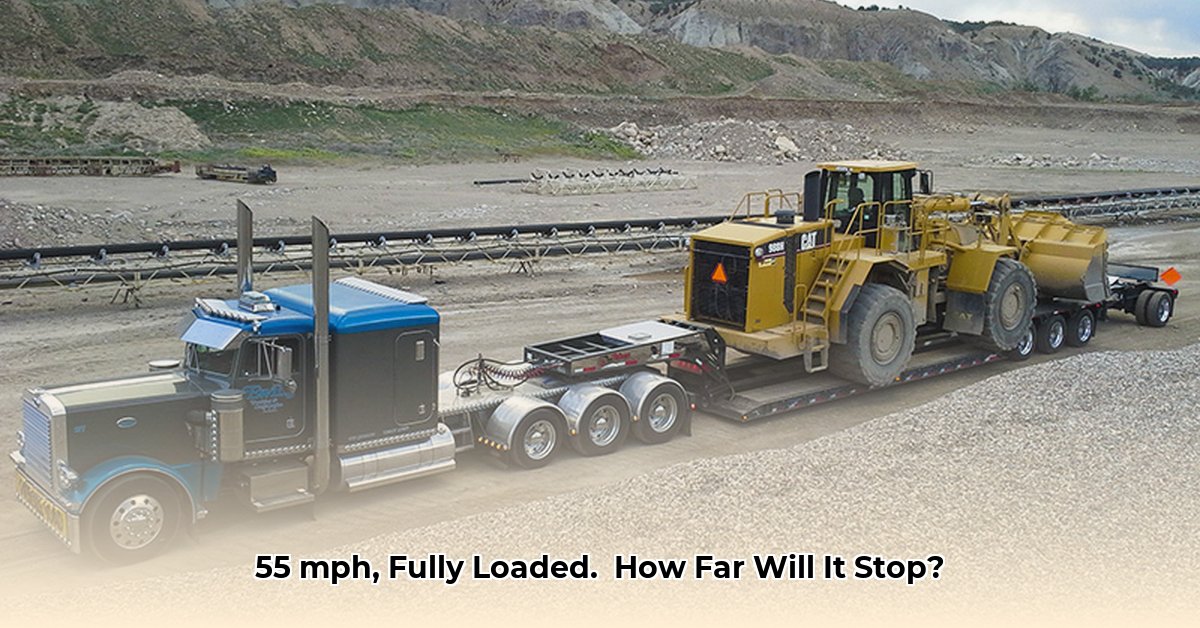
A Deep Dive into Safe Stopping Distances for Tractor-Trailers
Stopping a fully loaded tractor-trailer traveling at 55 mph is significantly more complex than stopping a car. The sheer mass and momentum of these vehicles demand far greater stopping distances, influenced by numerous factors. Understanding these factors is crucial for driver safety, fleet management, and regulatory oversight. This guide provides actionable insights based on real-world data and expert analysis. For more on vehicle dimensions, see tractor trailer width.
Factors Affecting Stopping Distance
Several key factors influence the stopping distance of a fully loaded tractor-trailer at 55 mph. These factors interact, creating a complex picture where the total stopping distance can vary dramatically.
Road Conditions: Dry pavement offers the best traction. However, wet, snowy, or icy roads drastically reduce friction, significantly increasing stopping distances. Isn't it crucial to understand how much longer it takes to stop on these less-than-ideal road surfaces?
Vehicle Maintenance: Worn brakes, bald tires, or other mechanical issues dramatically increase stopping distances. Regular maintenance, including brake inspections and tire pressure checks, is paramount. How much longer might stopping take with faulty brakes?
Driver Factors: Driver reaction time, alertness, and experience heavily influence stopping distance. Distraction, fatigue, and impairment can add considerable braking distance. How does a driver's reaction time translate into extra stopping distance?
Grade: Downhill grades increase speed, making braking less effective and dramatically lengthening the stopping distance. Uphill grades have the opposite effect, though to a lesser extent.
Cargo Weight: While heavier loads can slightly increase tire grip, the larger momentum negates most of this potential benefit. A heavier load requires far greater stopping distance even under identical conditions.
The Three Stages of Stopping
The stopping process for a heavy vehicle is composed of three distinct stages:
Perception/Reaction: The time it takes the driver to perceive a hazard and begin braking. This stage is highly variable.
Braking: The period during which the brakes are applied and the vehicle decelerates. This stage is heavily influenced by road surface, brake condition, and vehicle weight.
Stopping: The moment the vehicle comes to a complete stop.
Each stage adds to the overall stopping distance.
Real-World Stopping Distances: A Wide Range
While precise calculation is complex, real-world data suggests that stopping a fully loaded semi-truck at 55 mph can range from approximately 196 feet under ideal (dry road, excellent brakes, alert driver) conditions to well over 400 feet, or even more, under less favorable circumstances (wet roads, worn brakes, driver distraction). The potential increase is considerable, underlining the importance of safety margins.
Practical Safety Measures for All Stakeholders
The significant stopping distances of tractor-trailers necessitate a multi-faceted approach to safety:
For Truck Drivers:
Defensive Driving: Maintain a significant following distance—at least six seconds at 55 mph—to allow ample reaction time.
Regular Maintenance: Ensure regular inspections and maintenance of brakes, tires, and other critical components.
Minimize Distractions: Avoid all distractions while driving to maximize reaction time.
Prioritize Rest: Combat driver fatigue through sufficient rest and adherence to hours-of-service regulations.
For Trucking Companies:
Invest in Training: Provide comprehensive driver training, emphasizing safe braking techniques, hazard perception, and defensive driving strategies.
Maintain a Fleet: Implement a rigorous vehicle maintenance program to prevent brake failure and mechanical issues.
Embrace Technology: Consider adopting advanced driver-assistance systems (ADAS) to enhance safety.
For Regulatory Bodies:
Standardize Testing Protocols: Develop and implement consistent methods for evaluating stopping distances under varied conditions.
Enforce Safe Following Distances: Strictly enforce regulations regarding minimum following distances for heavy vehicles.
Support Safety Research: Continue investing in research to improve braking systems and driver safety technologies.
Assessing the Risks: A Simplified Matrix
Understanding the likelihood and severity of risks is essential for developing effective safety strategies. The following matrix provides a simplified assessment, acknowledging that actual risks vary widely:
| Factor | Likelihood | Severity | Risk Level | Mitigation Strategies |
|---|---|---|---|---|
| Brake Failure | Moderately Likely | Very Serious | High | Regular maintenance, redundant systems |
| Tire Failure | Less Likely | Moderately Serious | Moderate | Regular inspections, pressure monitors |
| Driver Error (Reaction Time) | Moderately Likely | Moderately Serious | Moderate | Training, fatigue management, ADAS |
| Adverse Weather | Highly Likely | Very Serious | High | Route planning, weather monitoring |
Calculating Stopping Distance: A Simplified Model
Precise calculation requires sophisticated engineering models. However, a simplified approach can illustrate the key factors:
Reaction Distance: Assume a reaction time of 1.5 seconds (this is a conservative estimate, and should be higher in adverse conditions). At 55 mph (approximately 80.67 feet per second), the reaction distance is about 121 feet (1.5 seconds * 80.67 feet/second).
Braking Distance: This is highly dependent on road conditions and brake maintenance. A conservative estimate on dry pavement is 300-400 feet. Wet pavement could easily double this.
Total Stopping Distance: Sum the reaction and braking distances. In ideal conditions, this may be roughly 421 feet; in less-than-ideal conditions, it will be significantly greater.
Safe Following Distance: A Crucial Element
Given the substantial stopping distances, maintaining a generous following distance is critical. A six-second rule (or more in adverse conditions) is strongly recommended.
Conclusion
Ensuring the safety of tractor-trailers requires a collective effort. Understanding the factors that influence stopping distances, implementing comprehensive safety measures, and promoting effective driver training are all crucial for mitigating risks and preventing accidents. The information provided here offers a starting point for improving safety on our roads.